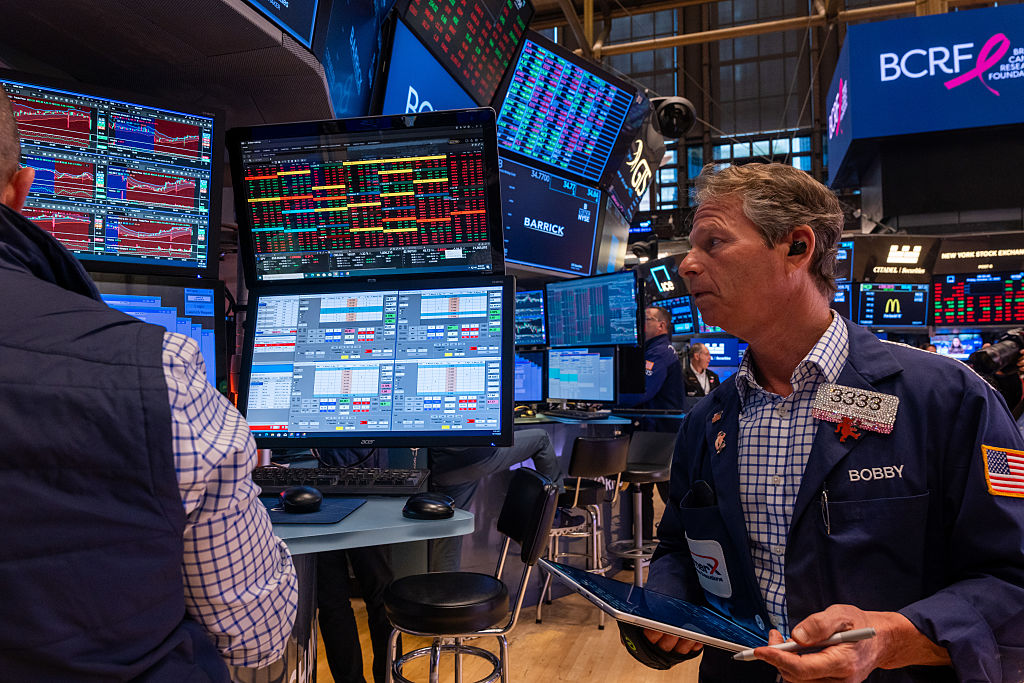Why equity markets are due a correction
We are now in the second longest period the Dow Jones has gone without suffering at least a 10% correction. Find out when leading market commentators - and the key indicators - think it will hit.
It is now the second longest period since the Dow Jones Industrial Average suffered at least a 10% correction. The latest count is 1,022 trading days, just exceeding the 1956 figure of 1,020 days but still second to 1997 which was 1,723 days, the other eight such periods since 1929 ranged from 617 to 960 days. The important words above are "at least" because the awaited, inevitable correction, when it arrives, could be, and probably will be, much bigger than 10%!
Market correction: key names voice concerns
A number of key names have, over the last week or two, voiced their concerns:
Ken Murray, a leading UK fund manager and founder of Blue Planet Investment Management, has sold 50% of his funds' equity holdings and expects a US recession to wipe 20% off the world's markets.
MoneyWeek
Subscribe to MoneyWeek today and get your first six magazine issues absolutely FREE

Sign up to Money Morning
Don't miss the latest investment and personal finances news, market analysis, plus money-saving tips with our free twice-daily newsletter
Don't miss the latest investment and personal finances news, market analysis, plus money-saving tips with our free twice-daily newsletter
Neil Woodford, Invesco Perpetual Fund Manager has said "I believe we are in for more turbulent times."
John Kennedy, Scottish Investment Trust "We are coming to the end of an upswing."
Stephen Roach, Chief Economist at Morgan Stanley recently wrote:
"The bursting of two bubbles seven years apart dot-com and housing - holds the key to the macro outlook. While different in many respects, these sharp swings in asset markets share one thing in common the initial belief that any spill-overs would be limited and that the rest of the economy and the financial markets would remain unscathed. Just as that view turned out to be wrong in the early 2000s, I fear a similar outcome today.
"a post bubble macro contagion that could end up being a good deal worse over the next year than it was seven years ago. What's especially worrisome about the current situation is that real GDP growth has already slowed to just over 2% over the past three quarters - far short of the 3.7% annualised pace of the previous three years. Yet this down-shift is largely an outgrowth of a steep recession in homebuilding activity, together with collateral impacts of a recent downtrend in business capital spending. By contrast, the American consumer has barely flinched, with average gains of 3.2% in real consumption since mid-2006 representing only a modest downshift from the astonishing 3.7% growth trend of the past decade. Should the consumer move into a more meaningful period of consolidation precisely the risk as equity extraction from residential property now slows in a post-housing bubble climate then macro contagion could become an increasingly serious problem.
"Given the likelihood of meaningful consumer spill overs, I would place about a 40% probability of an outright recession scenario in late 2007 and early 2008.
"It would take a Volcker-like toughness to bring this insidious process to an end. Yet both Greenspan and Bernanke seem to be cut from a very different cloth."
Market correction: has subprime meltdown been contained
It is generally thought that the recent stock market turbulence is now over and although the rally in major markets, particularly in the US and the UK, have failed as yet to exceed the year's earlier highs, nonetheless it is expected that will happen soon. Should stock markets however fall from current levels, it could all get very ugly, very quickly! Two key levels mentioned in earlier issues of this newsletter are for FTSE 100, 6000 and for the Dow Jones Industrial Average, 12000. Any near-term weakness that brings prices below those levels would subsequently see selling vigorously accelerate.
If the US is to suffer a recession later this year or early next year, then by that time stock markets will already need to be at or near their lows; so it would not be unreasonable to expect declines to happen in the near future. If not, the likes of Stephen Roach, Ken Murray and others will find themselves in the wrong camp. We will witness, over the coming weeks and months, either scrambling to get out of or scrambling to get back into markets as either the bullish camp or the bearish camp finds themselves wrong.
It is no secret that at RHAM we expect the worst and that the driver of market deterioration will be a developing credit crunch. The optimists believe that the US sub-prime mortgage market can be contained; however, we maintain, and have written in length, that loose lending practices are everywhere. Such destructive lending practices typically happen at asset market peaks.
The first quarter 2007 saw a record $1,000 billion total of M&A deals with a large percentage of these financed using covenant-lite loans. The IMF consider this situation serious enough to issue an important warning to the private equity industry saying that a large scale collapse in the sector is increasingly possible and that many of the major deals currently being mulled over could prove a disappointment. It also said that the potential problems with the buy-out industry were among the biggest risks facing the global economy.
Market correction: outlook for corporate profitability
Perhaps as important as any issue, is the prospective outlook for US corporate profitability. The fourth quarter 2006 was the 14th consecutive quarter of double digit profit growth, it is generally agreed that has now ended. For the first quarter 2007, according to Thomson Financial, we will see the average rise in profits as low as 3%. As recently as January they estimated the figure was going to be much higher, 8.7%. Declining profit growth will tend to restrict even further the low current levels of corporate America's capital expenditure. One corporate's capital expenditure is another's revenue; so lower profits will generate lower capital expenditure; lowering further profit expectations, etc., etc., etc.
The final concern that has raised its head this last two or three weeks is that the US service sector, so important for economic growth in the developed world, appears to be slowing.
Do the market indicators point to a correction?
The white horse - false peace - The Volatility Index (VIX)
Currently holding above 12.5 having earlier in March pushed to above 20. Complacency hasn't returned completely, the chart is still registering mild nervousness. The two levels arrowed on the chart are important; below 11.2, complacency will have returned; a move above 16 could catch out the unwary and raise fear levels significantly.
The red horse war and destruction The Philadelphia House Market Index
There is no good news. Each week seems to bring new concern for the US housing market. The latest was from American Home Mortgage Investment Corporation, who are not sub-prime lenders but prime and near-prime lenders, they issued a stark profit warning and their shares fell 17% on the day. They also said that they were experiencing a high number of mortgage delinquencies. As we have said previously, lax lending is everywhere, not just in the sub-prime market. A very significant percentage of sub-prime mortgage lending has been taken on by the prime mortgage market, much of it at prime terms; this, in the UK, has shattered the profits of the Kensington Group, specialist sub-prime UK mortgage lenders who can no longer charge an appropriate rate for the lending risk because the big boys are closing their eyes to bad credit risk applications so as to increase their market share.
The black horse famine and unfair trade Dow Theory
February highs and the March lows for the Industrials and Transports are key. On both simultaneously exceeding one or the other, an important signal will be confirmed. Until then, the jury is out. We watch and wait. If the final outcome is a violation of each of the March lows then what would follow, in our view, would be stock markets cascading downwards.
Dow Theory is quite complex when you get into the detail but in simple terms, relies upon the theory that the US economy is doing good when goods are being made (the Industrials) and then being delivered (the Transports). When one is doing well and the other is doing badly, something is wrong; when both are doing well everything is good; when both are doing badly everything is bad! News this week provided a further insight into this issue, the FT reported that the weakening US economy hits truck makers. The American Trucking Association seasonally adjusted tonnage index has fallen for eight consecutive months on a year-on-year basis. In February it dropped 1.7%. Commenting on trucking orders, Kenny Vieth, a partner at ACT Research, recently told a conference call "We don't think there is anything that is going to stimulate orders before September".
The pale horse sickness and death The Inverted Yield Curve
Although US 30-year yields have risen, they still remain below US 3-monthly market rates. It has to be said though, there has been a recent incline in the curve as the 10-year yields have slightly exceeded the 2-year yields. The extreme of the curve is still inverted but within the curve a modest change has taken place. The implications of this will come through over time.
By John Robson & Andrew Selsby at RH Asset Management Limited, as published in the Onassis Newsletter, a fortnightly newsletter that gives insight into the investment markets.
For more from RHAM, visit https://www.rhasset.co.uk/
Get the latest financial news, insights and expert analysis from our award-winning MoneyWeek team, to help you understand what really matters when it comes to your finances.
MoneyWeek is written by a team of experienced and award-winning journalists, plus expert columnists. As well as daily digital news and features, MoneyWeek also publishes a weekly magazine, covering investing and personal finance. From share tips, pensions, gold to practical investment tips - we provide a round-up to help you make money and keep it.
-
 Why Trustpilot is a stock to watch for e-commerce exposure
Why Trustpilot is a stock to watch for e-commerce exposureTrustpilot has built a defensible position in one of the most critical areas of the internet: the infrastructure of trust, says Jamie Ward
-
 Tetragon Financial: An investment trust with stellar returns
Tetragon Financial: An investment trust with stellar returnsTetragon Financial has performed very well, but it won't appeal to most investors – there are clear reasons for the huge discount, says Rupert Hargreaves

